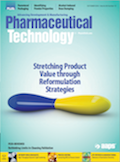Advances in Fluorination Chemistry for API Synthesis
Safer solid reagents and new coupling chemistry are important developments.
ROGER HARRIS/SCIENCE PHOTO LIBRARY/GETTY IMAGES

Fluorine atoms have a unique combination of electronic and physical properties. As such, when incorporated into APIs, fluorine atoms often influence their protein binding affinity and lipophilicity. Fluorination can thus significantly impact the bioavailability of drug substances. “Fluorination is a key reaction in organic synthesis, as evidenced by the fact that between 15% to 20% of all medicines and agrochemicals on the market contain at least one fluorine atom in their structure, where fluorine is used to modify properties of the drugs like lipophilicity and bioavailability or metabolic stability,” states Rafael Antunes, director of API portfolio development with Hovione.
Traditional and cost-effective fluorinating reagents are corrosive and often toxic and, therefore, require special handling and equipment. In addition, they cannot be used with intermediates containing other sensitive functionality. Thus, the synthesis of organic fluoro-compounds is not trivial at industrial scale--it requires special equipment, materials of construction, reaction conditions (sometimes cryogenic), and controls to tackle the difficulty in safely handling and disposing of fluorinating reagents, according to Antunes. “Reaction control is a fundamental aspect. The low selectivity (chemo-, regio-, and/or stereo-) of the reactions, the low stability of some fluorine-containing species, together with hazardous sampling and sample handling impose a heavy burden for the synthesis of fluorochemicals,” he adds.
The search for safer, easy-to-handle, inexpensive, and selective fluorinating reagents has been underway for decades and continues today. Most recently, solid reagents are showing promise, at least for use by medicinal chemists. Even more promising are coupling reactions that allow the incorporation of fluorinated synthons through carbon-carbon rather than carbon-fluorine bond formation.
New reagents show promise
Several solid fluorinating reagents have been introduced to the market. One example that has recently been attracting more interest is XtalFluor-E from Manchester Organics (developed in partnership with OmegaChem). (Diethylamino)difluorosulfonium tetrafluoroborate is an easily handled crystalline solid with enhanced thermal stability when compared to other reagents in this class, including a higher decomposition temperature with lower exothermic heat and higher onset temperature for self-accelerated decomposition (1), according to Dave Tovell, director of Manchester Organics. In addition, it does not generate free hydrogen fluoride (HF) and thus is usually compatible with glass equipment. The partnership has also demonstrated that this fluorinating reagent typically produces fewer elimination side products, and thus greater selectivity, than more traditional nucleophilic fluorinating reagents.
With their attractive physical, reactivity, and health and safety profiles, these newer reagents are finding growing use at the discovery and early process phases of drug development. They do, however, carry a relatively higher cost than traditional fluorinating reagents (HF, potassium fluoride [KF] and fluorine gas [F2]) and thus are generally less economical for use on the commercial-scale.
Organometallic coupling reactions are most exciting
Newer difluormethylation and trifluoromethylation chemistry, which involves the formation of carbon-carbon bonds rather than direct fluorination, is one of the most exciting developments in organofluorine chemistry in recent years, according to Tovell. “These reactions occur under mild conditions and often tolerate many different functional groups,” he notes.
Hartwig’s trifluoromethyl(1,10-phenanthroline)copper ((Phen)Cu-CF3) reagent is an easily handled, thermally stable, single-component reagent for the trifluoromethylation of both electron-rich and electron-deficient aryl and vinyl iodides, including sterically-hindered iodoarenes, in high yields under mild conditions (2). Notably, aldehyde, nitroarene, ketone, and ester functionalities are tolerated. The reagent is sold under the trade name Trifluoromethylator by Catylix and is commercially available through Aldrich Chemical.
Shibata developed a method for the electrophilic α-trifluoromethylation of β-ketoesters using the fluorinated Johnson reagent [(oxido)phenyl(trifluoromethyl)-λ4-sulfanylidene]dimethylammonium tetrafluoroborate (3). Meanwhile, hypervalent iodine(III)-CF3 reagents developed by Togni are widely used for the trifluoromethylation of thiols, alcohols, phosphines, and heteroarenes (4-8). The radical trifluoromethylation of heteroarenes using the Langlois reagent (sodium trifluoromethanesulfinate) or zinc(II) bis(trifluoromethanesulfinate) (Zn(SO2CF3)2) with tert-butyl hydroperoxide have also been achieved by Baran (9-11).
Zinc difluoromethanesulfinate (DFMS), also developed by the Baran group (11), allows for the simple difluoromethylation of a wide range of heteroaromatic substrates in air. Nucleophilic difluoromethylation of carbonyls and imines can be achieved using (difluoromethyl)trimethylsilane (12), a reagent developed by Hu and coworkers.
There are numerous other research groups developing selective and high-yielding nucleophilic and electrophilic difluoromethylation and trifluoromethylation strategies for substrates ranging from carbonyl compounds to alkenes. “These new techniques for the selective incorporation of fluorine atoms into complex organic molecules under mild conditions are very exciting advances for API synthesis. The pharmaceutical industry is under increasing pressure to reduce costs, and any new technologies that can improve route efficiencies and yields and do so cost effectively will attract significant attention,” asserts Tovell. He adds that it is still early days with respect to the development of these types of chemistry and he expects further improvements in the coming years.
Organometal-catalyzed direct fluorination also of interest
Organometallic catalysts have also been applied to the direct fluorination of a variety of substrates. Two examples include Buchwald’s method for the nucleophilic fluorination of aryl triflates with cesium or potassium fluoride (13) and Ritter’s silver-catalyzed fluorination reaction in which aryl stannanes are converted to fluorides using silver triflate as the catalyst and F-TEDA-PF6, which is an anion-exchange product of Selectfluor (chloromethyl-4-fluoro-1,4-diazoniabicyclo[2.2.2]octane bis(tetrafluoroborate); F-TEDA-BF4) as the fluoride source (14).
Antunes adds that the development of Selectfluor by Eric Banks (marketed by Air Products) is the most important ‘recent’ development. This reagent has transformed the production of fluorinated pharmaceuticals, with 134 patents published that cite Selectfluor, and approximately 80% of all fluorinated steroids produced using the agent. “This reagent bypasses hazardous fluorine processing steps and makes the production of drugs containing fluorine much cheaper and safer. Every year, around 25 tonnes (worth $7.5 million) of Selectfluor are used in the industry, making it the most commonly used electrophilic fluorinating agent in pharmaceutical manufacturing,” he notes.
Exploring the potential of flow chemistry
The benefits of flow chemistry include reduced operating costs, a lower footprint, decreased capital expenditures combined with improved process efficiencies, control, and product quality, and the ability to perform chemical reactions that are not feasible or present significant hazards in batch operations. As a result, there is great interest in this technology for the synthesis of pharmaceutical intermediates and APIs.
Not surprisingly, flow chemistry is a natural fit with fluorination reactions, particularly those involving conventional toxic and corrosive reagents. “Minimizing the quantity of reagents that are needed at any one time not only reduces the hazards associated with these reactions, but also allows for optimization of yields and selectivities,” Tovell explains. There are generally high expectations for flow chemistry to overcome many of the challenges of traditional fluorination reactions (the need for special equipment, to handle hazardous chemistries, and run strictly controlled reactions) due to more efficient mass and energy transfers, short residence times, and moisture free-operating conditions, agrees Antunes.
These benefits shouldn’t be limited just to traditional fluorination chemistry, however. “Combination of flow chemistry with the newer difluoromethylation and trifluoromethylation techniques has the potential to provide low-cost, highly effective routes to complex fluorinated molecules,” says Tovell.
Manchester Organics will be investigating the application of a continuous-flow approach to various fluorination strategies over the next few years. One of the challenges involves optimizing the conditions for reactions that require the use of solid reagents. There are numerous parameters to consider, such as the dilution factor, solvent choice, and reaction temperature. “There is a lot of work to be done, but we believe that this approach will enable the development of effective solutions for many of our customers that are looking for improved methods for the production of their fluorinated compounds,” Tovell observes.
More diversity to come
Since the first introduction of reagents with improved handling and toxicity profiles, such as (2-methoxyethyl)aminosulfur trifluoride (Deoxo-Fluor), Selectfluor, and diethylaminosulfur trifluoride (DAST), there has been an explosion in the development of new fluorination methods.
Access to solid reagents such as XtalFluor-E and FLUOLEAD from UBE Industries has led to even further advances in fluorination chemistry, with the number of literature reports on new techniques growing exponentially, according to Tovell. Studies of the reactivities of these various reagents combined with new data obtained using state-of-the-art analytical and modeling technologies are enabling researchers to gain a better understanding of the interactions of fluorine with other atoms in different molecular settings. Tovell believes that this new knowledge will lead to the development of even more effective fluorinating reagents that are highly selective (chemo-, regio-, and stereo), safer to use, can tolerate a wider range of functional groups, are environmentally acceptable, and can be produced at a cost level that will facilitate their use in commercial drug manufacturing.
References
1. M. Couturier et al. J. Org. Chem. 75(10), 3401-3411 (2010).
2. J.F. Hartwig et al., Angew. Chem. Int. Ed. 50(16), 3793-3798 (2011).
3. N. Shibata et al., Eur. J. Org. Chem. 20, 3465-3468 (2008).
4. A. Togni et al., Chem. Eur. J. 12(9), 2579-2586 (2006).
5. A. Togni et al., Angew. Chem. Int. Ed. 46 (12), 754-757 (2007).
6. A. Togni et al., Chem. Commun. 13, 1575-1577 (2008).
7. A. Togni et al., J. Org. Chem. 73(19), 7678-7685 (2008).
8. A. Togni et al., Org. Synth. 88, 168-180 (2011).
9. P.S. Baran et al., Proc. Natl. Acad. Sci. 108(35), 14411-14415 (2011).
10. P.S. Baran et al., J. Am. Chem. Soc. 134(3), 1494-1497 (2012).
11. P.S. Baran et al., Nature 492(7427), 95-99 (2012).
12. J. Hu et al., Org. Lett. 13(19), 5342-5345 (2011).
13. S. Buchwald et al., Science 325(5948), 1661-1664 (2009).
14. T. Ritter et al., J. Am. Chem. Soc. 132(34), 12150-12154 (2010).
Article DetailsPharmaceutical Technology
Vol. 39, No. 10
Page: 48–51
Citation:
When referring to this article, please cite it as C. Challener, “Advances in Fluorination Chemistry for API Synthesis," Pharmaceutical Technology 39 (10) 2015.

Drug Solutions Podcast: A Closer Look at mRNA in Oncology and Vaccines
April 30th 2024In this episode fo the Drug Solutions Podcast, etherna’s vice-president of Technology and Innovation, Stefaan De Koker, discusses the merits and challenges of using mRNA as the foundation for therapeutics in oncology as well as for vaccines.
Drug Solutions Podcast: Applying Appropriate Analytics to Drug Development
March 26th 2024In this episode of the Drug Solutions Podcast, Jan Bekker, Vice President of Business Development, Commercial and Technical Operations at BioCina, discusses the latest analytical tools and their applications in the drug development market.
INTERPHEX 2025: Use of Walk-In Chambers for Bio/Pharma Development and Manufacturing
April 2nd 2025Sitting down with the PharmTech Group at INTERPHEX 2025, Christopher Murphy, director of Global Business Development and Service Customer Support at Environmental Specialties, discusses the design and critical role of walk-in chambers in the bio/pharmaceutical industry.